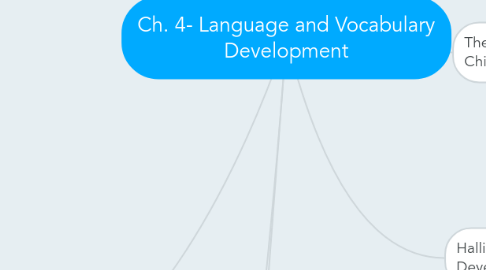
1. Brain Development and Language and Literacy Development from Birth to Age 3
1.1. Brain connections that are repeated and used become permanent; when brain connections are not used, they disintegrate and vanish which is called neural shearing
1.2. The connecting of the brain cells is called synaptogenesis or the rapid development of neural connections which happens at about 1 month of age
2. Stages in Language Development
2.1. From Birth to Year 1- first few months where oral language consists of a child's experimenting or playing with sounds, 8 to 10 months where babbling becomes more sophisticated, 8 to 12 months where children increase their comprehension of language dramatically and the understanding exceeds their ability to produce it
2.2. From Age 1 to 2- children begin to use telegraphic speech and 18 months most children can pronounce 4/5ths of the English phonemes and use 9 to 20 words
2.3. From Age 2 to 3- oral vocabulary grows from 300 to 1,00 words
2.4. From 3 to 4- at 4 children seem to have acquired all the elements of adult language
2.5. From 5 to 6- sound much like adults when they speak
2.6. From 7 to 8- developed a grammar that is almost equivalent to that of adults
3. Helping English Language Learners in Your Classroom
3.1. Include print in the classroom form the child's first language
3.2. suggest that ELL students share stories from their first language
3.3. make sure students can read and write with others who speak their language
3.4. allow children to talk
3.5. provide thematic instruction
3.6. write things based on the children's home life and experiences in school
4. Strategies for Language Development
4.1. Strategies for Language Development Birth to Age 2
4.1.1. Developing Language in the Child's first Year-by providing conversations and communication
4.1.2. Surround Infants with sensory objects
4.1.3. Language development at ages 1 to 2- people begin to expand and extend the child's language by helping increase the number of words the child is able to use in a sentence or by increasing the syntactic complexity of their own utterances
4.1.4. Scaffolding to help language develop
4.1.5. New experiences help develop language
4.1.6. Overgeneralizations and Language development- You do not have to correct children's overgeneralizations at this young age since they can learn and correct errors on their own later
4.1.7. Materials for language development at ages 1 and 2- more books, more hand-eye coordination objects, and toys with different textures
4.2. Strategies for Language Development in Early Childhood Classrooms
4.2.1. Center Materials for language development- appropriate materials to help generate language based on Science, Art, Music, Math, literacy, dramatic play, block area, workbench, and outdoor play
4.2.2. Develop Language with thematic units through discussion, word lists, pictures, sharing time, experiments, art, music, food preparation, dramatic play, outdoor play, morning message, class trips, reading/creating/telling stories, word walls, very own vocab words, and the summary of the day
4.2.3. Children's Literature and language development- use books that are interesting and help with vocab and reading and language skills
4.3. Expanding Vocabulary and Word Meaning in Second and Third Grades
4.3.1. Use semantic maps, context clues, vocabulary books, word parts, and the dictionary,
